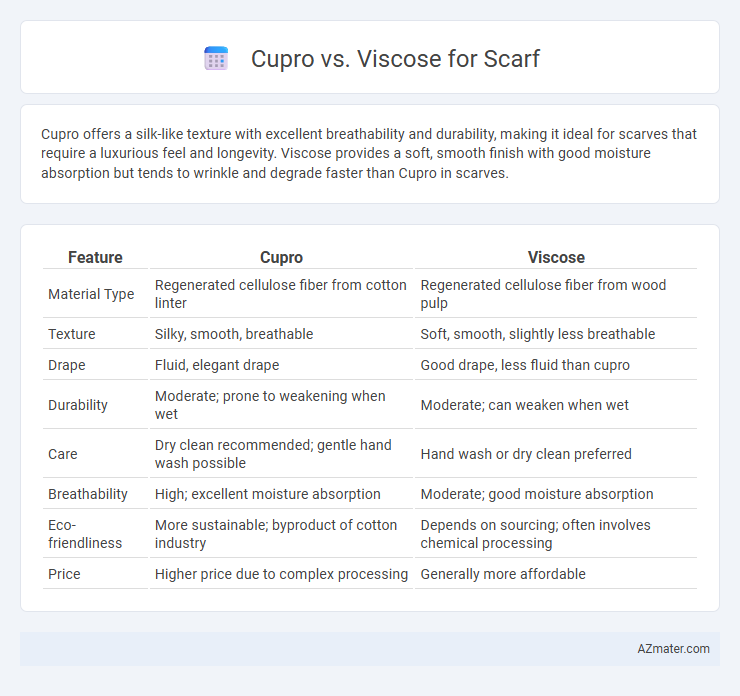Cupro offers a silk-like texture with excellent breathability and durability, making it ideal for scarves that require a luxurious feel and longevity. Viscose provides a soft, smooth finish with good moisture absorption but tends to wrinkle and degrade faster than Cupro in scarves.
Table of Comparison
| Feature | Cupro | Viscose |
|---|---|---|
| Material Type | Regenerated cellulose fiber from cotton linter | Regenerated cellulose fiber from wood pulp |
| Texture | Silky, smooth, breathable | Soft, smooth, slightly less breathable |
| Drape | Fluid, elegant drape | Good drape, less fluid than cupro |
| Durability | Moderate; prone to weakening when wet | Moderate; can weaken when wet |
| Care | Dry clean recommended; gentle hand wash possible | Hand wash or dry clean preferred |
| Breathability | High; excellent moisture absorption | Moderate; good moisture absorption |
| Eco-friendliness | More sustainable; byproduct of cotton industry | Depends on sourcing; often involves chemical processing |
| Price | Higher price due to complex processing | Generally more affordable |
Introduction to Cupro and Viscose
Cupro, a regenerated cellulose fiber derived from cotton linter, offers a silky texture and excellent breathability ideal for scarves, while viscose, produced from wood pulp, provides a soft and drapey fabric with high moisture absorption. Both materials maintain luxurious appearances, but Cupro stands out for its natural sheen and eco-friendly production process. Viscose is favored for its affordability and versatility in vibrant dyeing, making it a popular choice in fashion accessories like scarves.
What is Cupro?
Cupro is a regenerated cellulose fiber derived from cotton linter, known for its smooth, silk-like texture and excellent breathability, making it an ideal fabric for scarves that require both comfort and elegance. Unlike viscose, which is chemically processed from wood pulp, cupro maintains a higher level of purity and biodegradability, offering a more sustainable and skin-friendly option. The fabric's natural sheen and moisture-wicking properties enhance wearability, ensuring scarves made from cupro remain soft and stylish throughout the day.
What is Viscose?
Viscose is a semi-synthetic fiber derived from cellulose, primarily sourced from wood pulp, known for its silk-like feel and excellent breathability. It offers a smooth texture and vibrant dye uptake, making it a popular choice for scarves that require softness and color vibrancy. Compared to cupro, viscose tends to be more affordable but may wrinkle more easily and require gentler care to maintain its appearance.
Key Differences Between Cupro and Viscose
Cupro is a regenerated cellulose fiber derived from cotton linter, known for its silky smooth texture and breathability, while viscose is made from wood pulp and tends to have a slightly heavier, more absorbent feel. Cupro offers superior moisture-wicking properties and a luxurious drape that resists wrinkles better than viscose, making it ideal for high-end scarves. Viscose, although versatile and cost-effective, is less durable and can degrade faster with repeated washing, impacting the longevity of scarf fabrics.
Texture and Softness Comparison
Cupro fabric offers a smooth, silk-like texture with a natural sheen, making it exceptionally soft and gentle on the skin, ideal for scarves that require a luxurious feel. Viscose, while soft and breathable, has a slightly more fibrous texture and less luster compared to Cupro, providing a comfortable but less silky scarf experience. Both materials drape well, but Cupro's refined softness and silk-like finish typically surpass the cozy smoothness of Viscose scarves.
Breathability and Comfort
Cupro, a regenerated cellulose fiber made from cotton linter, offers superior breathability compared to viscose due to its fine fiber structure and moisture-wicking properties, making it ideal for scarves in warm climates. Viscose, also derived from cellulose but chemically processed with heavier treatments, tends to retain more moisture and can feel heavier, which may reduce overall comfort during extended wear. Scarves made from cupro provide a smoother, silk-like texture while maintaining airflow and comfort, enhancing their suitability for sensitive skin and all-day use.
Durability and Longevity
Cupro scarves exhibit superior durability compared to viscose due to their cellulose-based fiber structure, which resists pilling and tearing over time. Viscose, while soft and breathable, tends to weaken with repeated washing and prolonged use, leading to faster wear and reduced longevity. Choosing cupro ensures a longer-lasting scarf that maintains its texture and appearance through extended use.
Sustainability and Eco-Friendliness
Cupro, a regenerated cellulose fiber derived from cotton waste, offers superior sustainability compared to viscose by utilizing agricultural byproducts and involving fewer harmful chemicals in its production process. Viscose production, often linked to deforestation and toxic chemical use, poses greater environmental risks despite its similar origin from wood pulp. Choosing cupro for scarves supports a circular economy and reduces ecological impact through biodegradable properties and less resource-intensive manufacturing.
Care and Maintenance for Scarves
Cupro scarves require gentle hand washing in cold water or dry cleaning to maintain their silky texture and prevent shrinkage, while viscose scarves also demand careful hand washing with mild detergent to avoid weakening fibers and color fading. Both fabrics should be air-dried flat away from direct sunlight to preserve their delicate structure and vibrant appearance. Proper storage in a cool, dry place with minimal friction reduces the risk of pilling and fabric distortion for cupro and viscose scarves alike.
Which is Better for Scarves: Cupro or Viscose?
Cupro offers a luxurious silk-like feel with excellent breathability and moisture-wicking properties, making it a premium choice for scarves that require softness and comfort. Viscose provides vibrant color absorption and a smooth texture at a more affordable price point, making it ideal for fashion scarves with bold designs. For scarves prioritizing eco-friendliness and durability, Cupro is superior; for versatile, cost-effective options, Viscose remains popular.

Infographic: Cupro vs Viscose for Scarf
 azmater.com
azmater.com